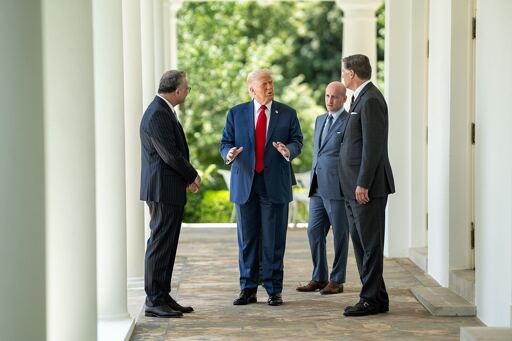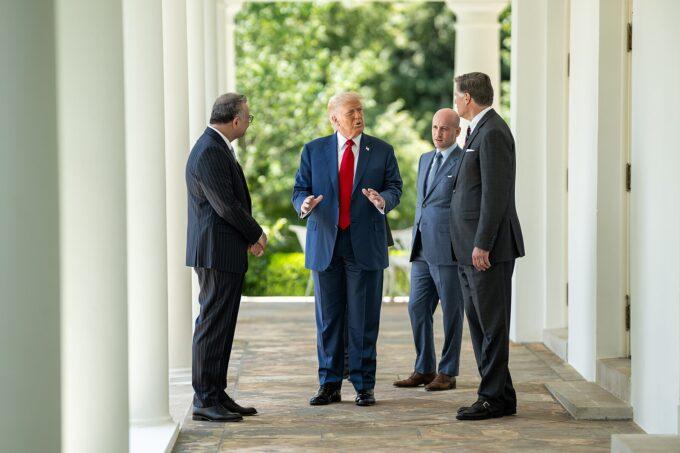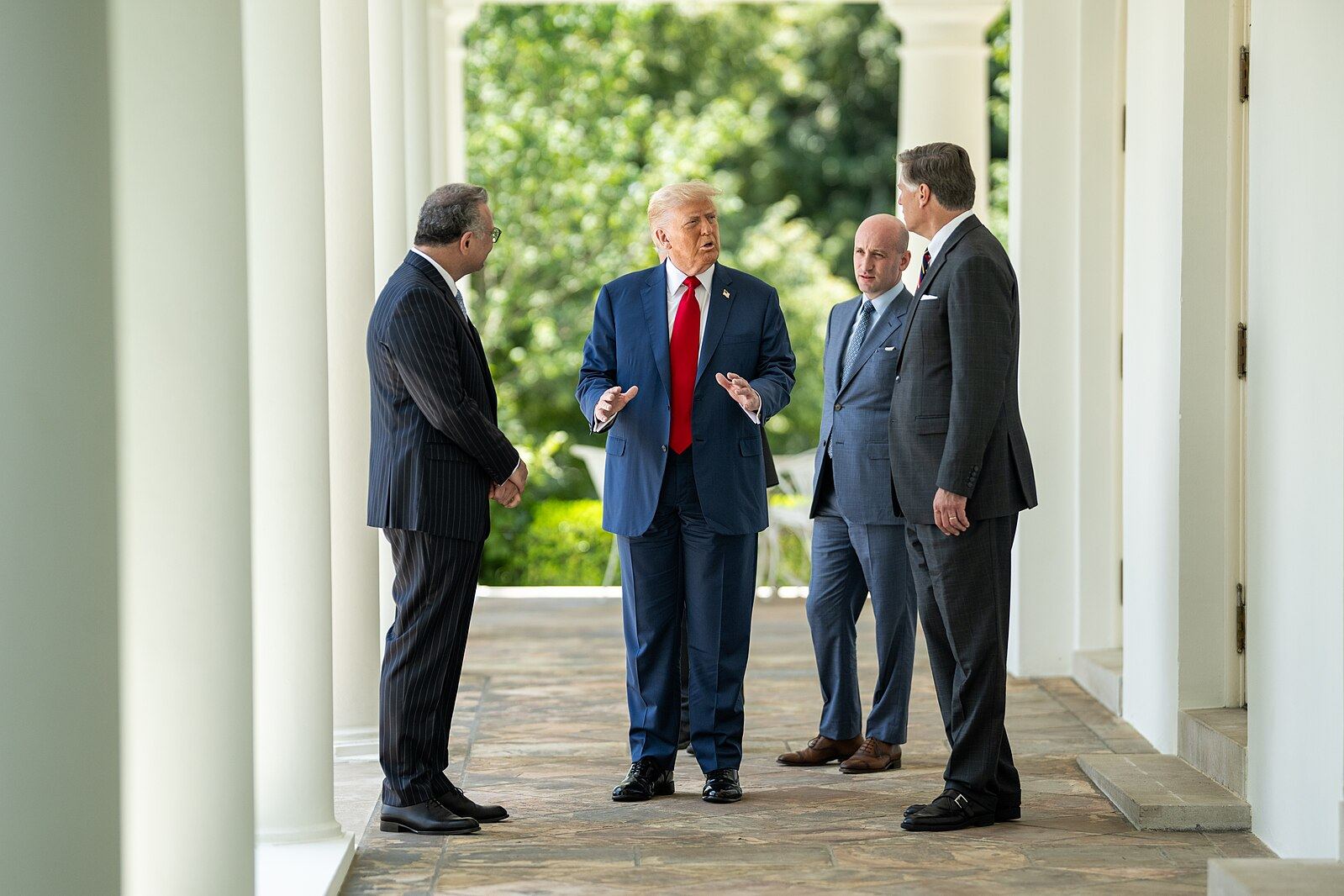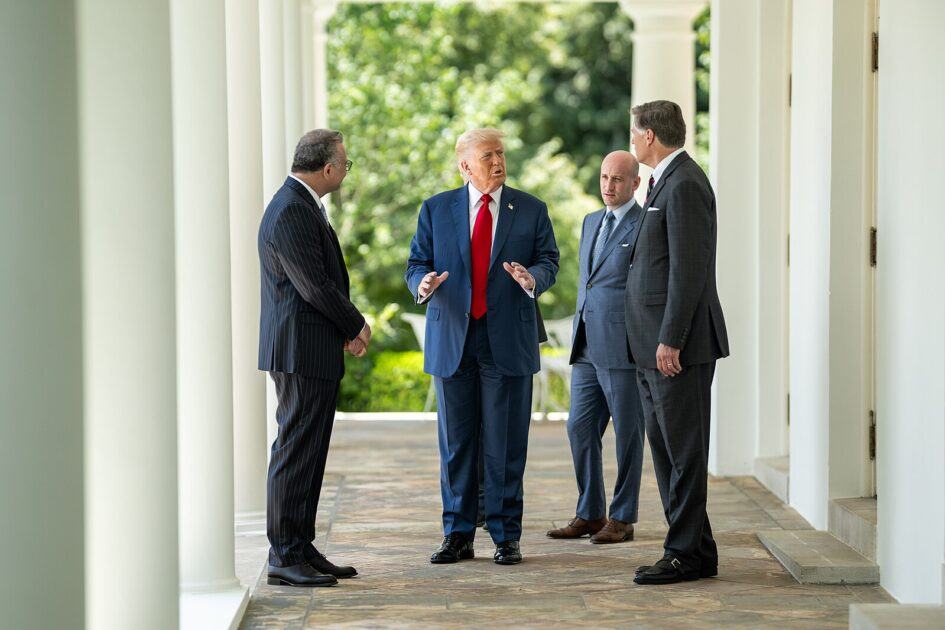Photograph Source: The White House – Public Domain
The current presidential administration has become a “manosphere,” a growing cult championing male supremacy. Its champions are led by:
• Donald Trump, President – the sex predator.
• JD Vance, Vice President – the everyman.
• +Pete Hegseth, Sec. of Defense – the warrior.
• + Stephen Miller, White House deputy chief of staff for policy — “Trump’s brain.”
Their manosphere is grounded in a broad anti-feminist ideology and the belief that men have been victims of the social change that has transformed the U.S. over the last half-century. Sadly, in today’s postmodern capitalist world, Trump’s manosphere includes some leading “ladies” of the administration as well, like Pam Bondi, Attorney General, and Kristi Noem, Secretary of Homeland Security.
On September 7, 1968, some 200 demonstrators — feminists and civil rights advocates – protested Miss America pageant in Atlantic City, NJ. Standing arm-and-arm on the boardwalk, women threw mops, make-up and bras into a “Freedom Trash Can.” Symbolically, the second-wave women’s movement was born.
Now, a half-century later, American women’s lives are very different. The St. Louis Federal Reserve reports that female labor-force participation rates best illuminate the changes that have occurred. It finds that in 1960, 44.2 percent of females worked but by 2024 it had increased to 77.5 percent. The Educational Policy Institute notes that higher education “gender distribution has flipped over the course of a 55-year period. While men had a 58 percent share of total enrollment in 1970, by 2025 they are estimated to have a 43 percent share with the women’s share reaching 57 percent.” And, as Pew Research finds, “The gender gap in pay has slightly narrowed in the United States over the past 20 years or so. In 2024, women earned an average of 85% of what men earned ….”
Clearly, women’s place in society has changed over the last half-century.
The resulting questions these findings raise is simple: what do they mean for men? In a profoundly changing America, what does it mean for a “man” to be a “man”?
In many cities like New York and its suburbs, one is accustomed to seeing both middle- and working-class men holding a baby or pushing a stroller. Throughout the country, for many — but by no means all — what was once considered “woman’s work” like raising children or cooking, clearing & shopping is now shared by adult partners. Most importantly, approximately half (49.6%) of all U.S. households is a dual income households and single women headed households made up about nearly 11.7 percent of all households.
Nevertheless, there is growing belief among conservatives that masculinity is facing a crisis. Matthew Gasda, writing the American Affairs Journal, warns, “Masculinity is desperate for a crisis. It is docile, unsure, and formless. At most, it is at the germinal phase of crisis ….” He adds:
*“*American boys and men are falling behind across a range of educational and economic indicators when compared to their female peers. They face higher rates of overdose, suicide, and incarceration; and they are more likely to exhibit deep social problems, such as friendlessness, failure to find romantic partners, and general signs of delayed development, from kindergarten to adulthood.”
He concludes his analysis, insisting: “The daunting task of piecing back together, albeit in novel combinations, the scattered fragments of the American social and economic order—and finding an honorable place for men and masculinity in it—could be this moment’s ‘moral equivalent of war.’”
The sentiment Gasda is referring to is known as “toxic masculinity.” It’s been applied to characterize lower-income, under-employed, marginalized and predominately younger white men who feel disenfranchised by society’s changes over the last half-century. Many who feel this way call for the restoration of traditional male-dominated families and family values.
Carol Harrington, a sociologist at Victoria University of Wellington, New Zealand, notes, “Toxic masculinity emerged within the mythopoetic men’s movement of the 1980s, coined by Shepherd Bliss.” And she adds, “During the 1990s and early 2000s, toxic masculinity spread from men’s movements to wider self-help, academic and policy literature.”
Where Trump wants to make America white again, Vance, Hegseth and Miller want to return the nation to the glory days of John Wayne. It was a rugged masculinity based on individualism, personal strength and unwavering moral principles. That those days existed only in Hollywood movies is irrelevant – the myth lives on and infuses elements of the conservative and Christian right with moral purpose.
Trump is an exaggeration of toxic masculinity. He is a man at the nexus of two contesting forces that define postmodern American life – hedonism and hypocrisy. Over the course of his adult life he morphed, like a recovering alcoholic, from an up-market hipster to a repentant moralist. He embodies a profound contradiction: he seems to love money as much as sex, both assertions of primitive masculine potency and power. His adult-life trajectory symbolizes the arch of the culture wars, especially the evolving sexual politics over the last half-century.
As has been often repeated reported, a jury found Trump guilty of sexually abusing E. Jean Carroll in 1996 and award her $5 million; she was subsequently awarded $83.3 million in a defamation judgement against Trump. He continues to appeal these judgments. In addition, at least 27 women have accused him of varying inappropriate behavior, including allegations of sexual harassment or sexual assault. Most disturbing, many others within his administration have been accused of being alleged sexual abusers.
VP Vance tells a different story. At the CPAC convention in February, Vance warned:
… my message to young men is I think that our culture sends a message to young men that you should suppress every masculine urge. You should try to cast aside your family. You should try to suppress what makes you a young man in the first place. …
The cultural message, and I think the President’s and mine is the exact opposite, but our cultural message is I think that it wants to turn everybody, whether male or female, into androgynous idiots who think the same, talk the same, and act the same. We actually think God made male and female for a purpose, and we want you guys to thrive as young men and as young women, and we’re going to help with our public policy to make it possible to do that.
He concluded, “when I think about what is the essence of masculinity, you could answer this in so many different ways, but when I think about me and my guy friends, we really like to tell jokes to one another. We like to laugh. You think of all the movies that were really popular.”
Hegseth, following Trump’s lead, has been very vocal in promoting the new masculinity, especially within the U.S. military. He insists that so-called woke policies are dead; “woke” covers what is perceived as the radical leftist agenda, especially those supporting “diversity, equity and inclusion” (DEI) programs.
“We’re training warriors, not defenders. We fight wars to win, not to defend. Defense is something you do all the time, it’s inherently reactionary and can lead to overuse, overreach, and mission creep. War is something you do sparingly, on our own terms and with clear aims,” Hegseth argued at the Marine Corps Base Quantico on September 30th.
Hegseth added, “We’re going to cut our hair, shave our beards and adhere to standards. Because it’s like the broken windows theory of policing, it’s like when you let the small stuff go, the big stuff eventually goes. If you want a beard, you can join Special Forces. If not, then shave.”
He then insisted:
“**… This is not about preventing women from serving. We very much value the impact of female troops. Our female officers and NCOs are the absolute best in the world.
*“*But when it comes to any job that requires physical power to perform in combat, those physical standards must be high and gender-neutral. If women can make it, excellent. If not, it is what it is. If that means no women qualify for some combat jobs, so be it. That is not the intent, but it could be the result. So be it. It will also mean that weak men won’t qualify because we’re not playing games. This is combat. This is life or death.”
Miller is a key figure in the Trump administration, supporting federal violence against immigrants as well as promoting white nationalist rhetoric. However, Miller’s “masculinity” was recently put to the test when Rep. Alexandria Ocasio-Cortez (D-NY) mocking his apparent height during a web streamed video.
“The point is that they are scraping and grasping at straws because they have nothing else. Laugh at them, Stephen Miller is a clown! I’ve never seen that guy in real life, but he looks like he’s, like, [4 feet, 10 inches tall]. He looks like he is angry about the fact that he’s [4 feet, 10 inches] and he has taken that anger out on any other population possible. Like, laugh at them,” she said. (Ocasio-Cortez later apologized to short men.)
Miller, on a Fox News show, replied in kind, arguing, “Well, we knew that her brain didn’t work. … Now we know that her eyes don’t work. So, the, she’s a mess, right? What a trainwreck. What a trainwreck.”
While Trump and some men within his administration warn of “toxic masculinity,” many Americans, including Trump supporters, don’t want what The New York Times, calls a “return to a more traditional masculinity either, one that requires men to be aggressive, dominant or stoic.” It adds, “Instead, they want Americans to have a different take on masculinity — one that is positive instead of negative, and broad instead of narrow.”
The post The Revenge of the Manosphere appeared first on CounterPunch.org.
From CounterPunch.org via this RSS feed






